Puebla – Mexico’s True Colonial City
This is my twelfth post on a recent trip to Central Mexico with Canadian tour company Adventures Abroad led by veteran tour guide Victor Romagnoli. After starting in Mexico City we flew to the wonderful city of Oaxaca for a four night stay, participating in the Day of the Dead ceremonies, visiting the Zapotec city of Mitla and enjoying the really great Oaxacan cuisine. As much as we all hated to leave Oaxaca, it was time to move on, this time to the city of Puebla which Victor promises will be a completely different experience. Since this tour will visit many Mexican colonial cities, one might ask why I’m naming Puebla ‘Mexico’s true colonial city’. The answer is simple – it’s the only major Mexican city that was not built upon an existing pre-Colombian settlement. So let’s find out what makes Puebla so different.
Oaxaca to Puebla
It’s a five hour bus ride from Oaxaca to Puebla including comfort stops, but as always when traveling on a road I’ve never traversed before, I found it interesting. The journey involved crossing a high mountain pass through a landscape that most people would think is stereotypical Mexican. It was a dry desert with great numbers of organ pipe and saguaro cacti spread along the hillsides like an army waiting to descend into the valleys below. Stupidly, I did not take any photos of these beautiful specimens, ignorantly thinking that this was the type of landscape we would be seeing throughout Mexico. I was wrong. We never saw it again, so if you take this trip in the future make sure to photograph the cacti on the way from Oaxaca to Puebla.
What I did take a picture of was something far more common. This is field of cultivated prickly pear cacti that are a staple of Mexican cuisine. We did see these in a lot of places, but none as large as this field.
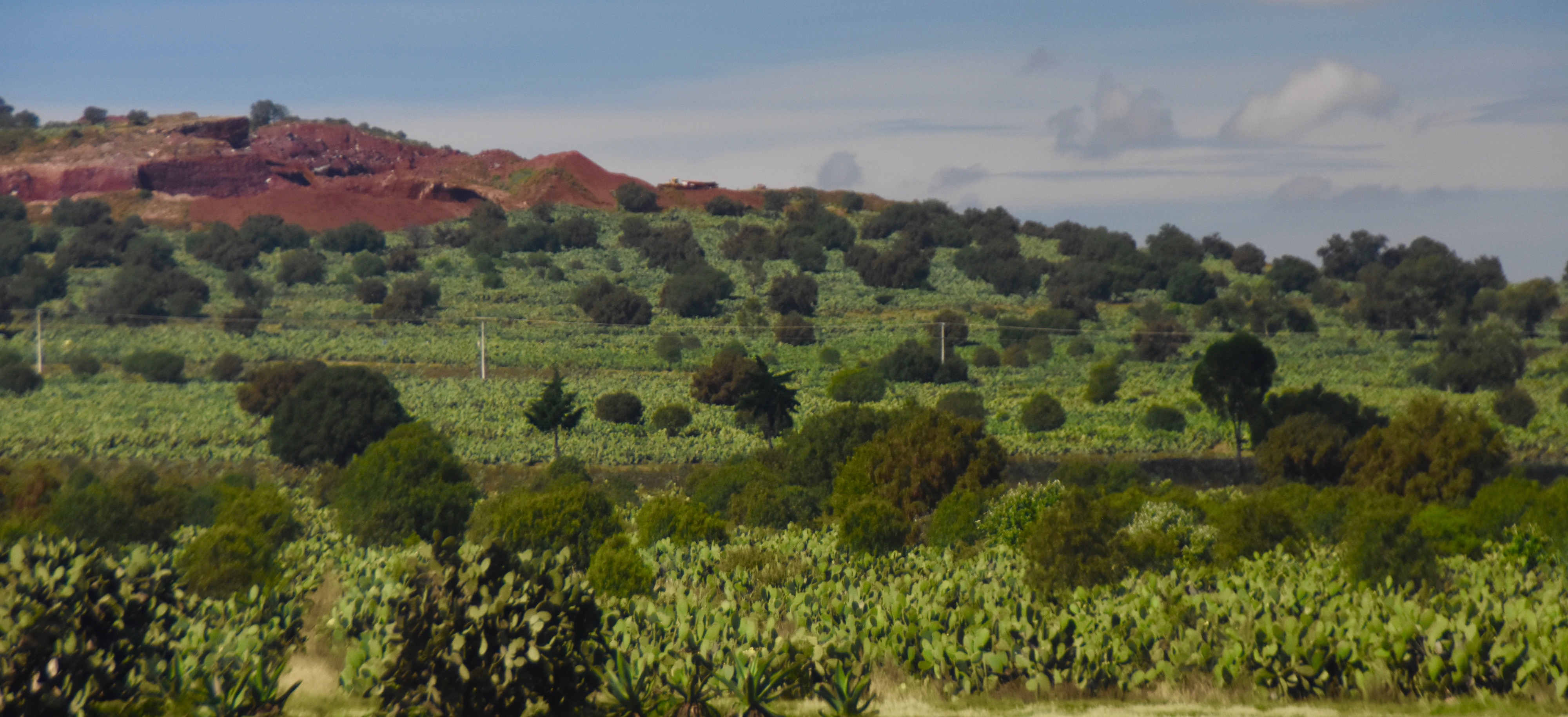
Also of interest along the way were the occasional cemeteries still festooned with flowers from the Day of the Dead festivities.

Entering Puebla from the south you come across a huge monument to the first Battle of Puebla which was fought on May 5, 1862 just outside Puebla. It was a victory for an undermanned Mexican army against the superior forces of the French who weren’t winning much in those times (the disastrous Franco-Prussian War was only eight years away). I took this photo from the moving bus. Technically it’s the monument to the winning general Ignacio Zaragoza who is the fellow on horseback.
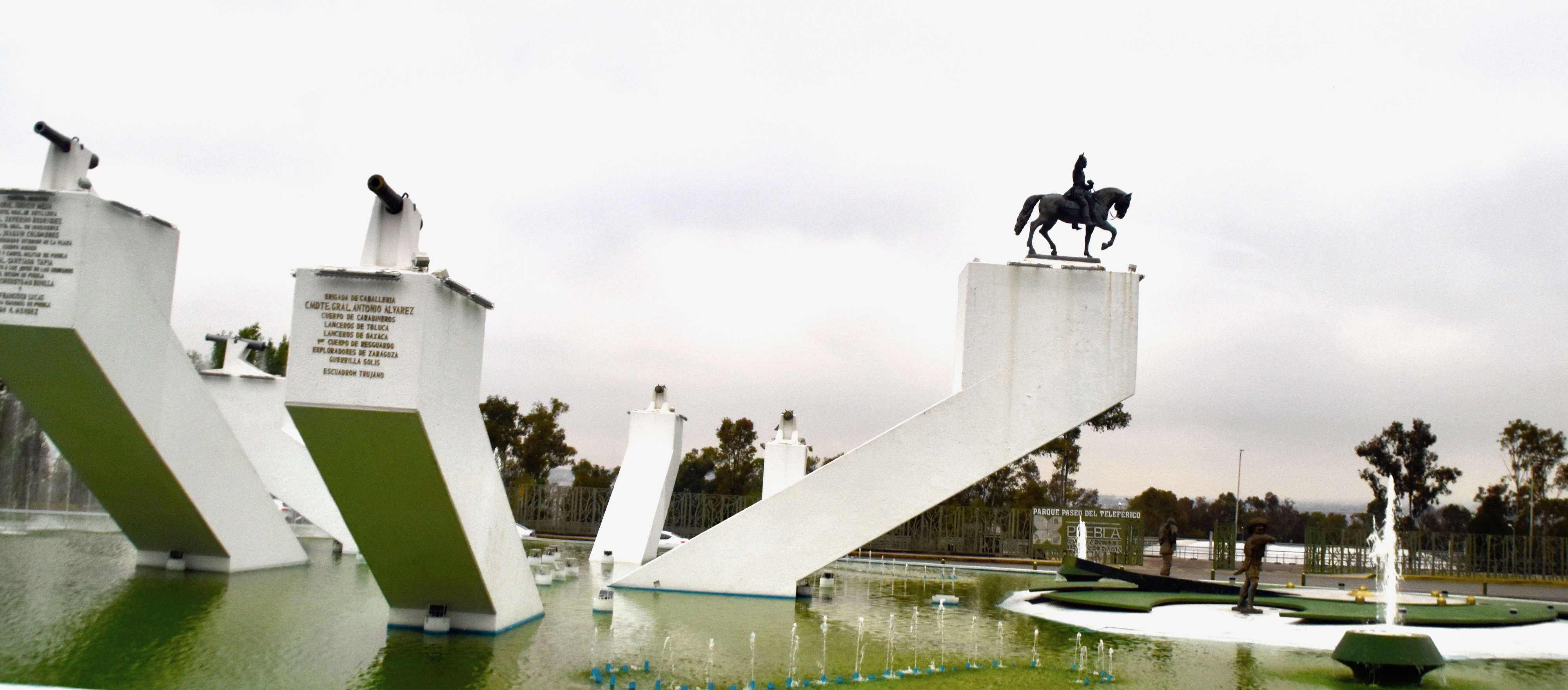
By now you might be thinking “May 5th – that’s Cinco de Mayo, the big Mexican celebration”. You would be right and wrong at the same time. It is the same Cinco de Mayo celebrated by Americans, mostly of Mexican descent, but in Mexico it’s not a big deal, except in Puebla. It is not a national holiday and had nothing to do with Mexican independence which was long secured by 1862. To top it off the French came back and won a second more decisive battle and occupied Puebla on May 19. Mexicans are bemused by the over the top celebrations that take place in El Norte. The reality is that Cinco de Mayo is a commercial construct driven mostly by beer companies. It also happens to be my anniversary date which is far more important (at least to Alison and me).
History of Puebla
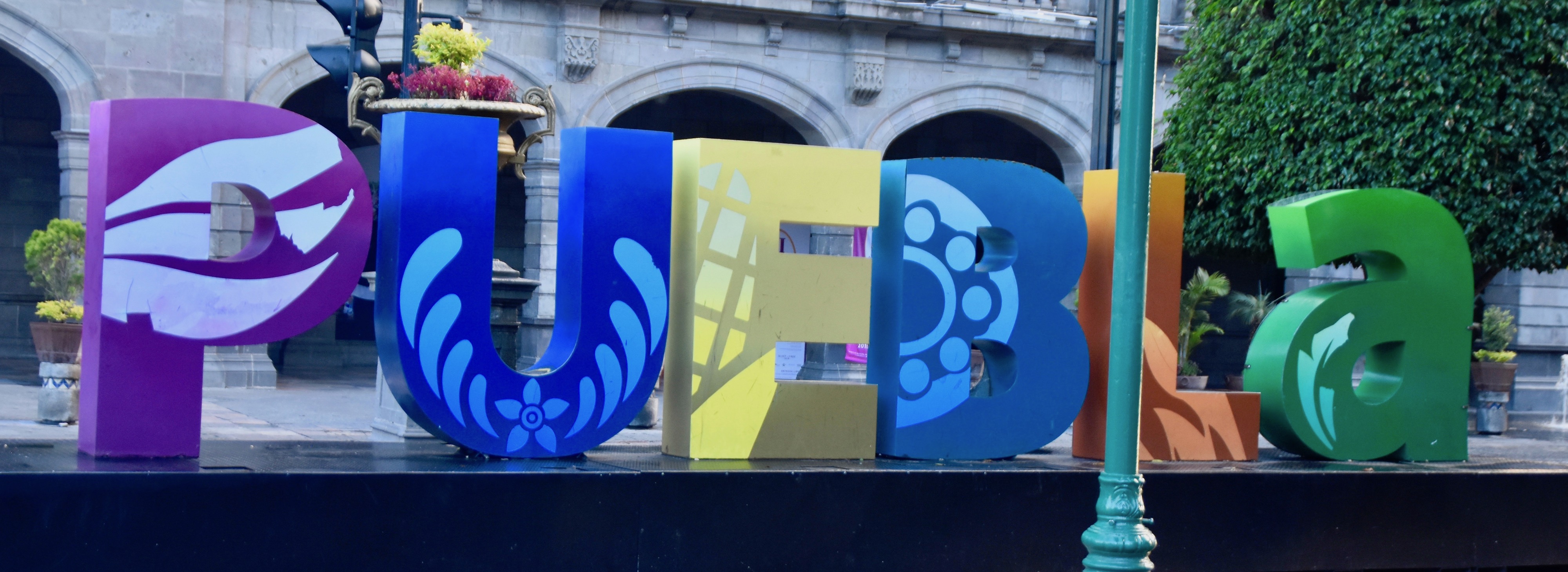
As noted in the introduction Puebla is the only major Mexican city that was actually founded by the Spanish and not by the Indigenous peoples already on site. By 1530 it was apparent that Mexico City was going to be the capital and most important city in New Spain as the Spanish named what is now Mexico and huge swaths of western United States. Veracruz was the Atlantic port that was the major entry and exit point for the colony. Puebla was founded in 1531 as a stopping point on the main road connecting Veracruz and Mexico City. As is often the case with cities founded by a religious order as was Puebla there is a certain amount of gobbledegook associated with why it was founded where it was. In Puebla’s case the Mexico City bishop supposedly had a dream of angels drawing out the outline of a city in a place of rivers and woods. He marched his minions out into the country and when they found a place suitable for a new city because it had water and lumber he knew this must be the place. Thus the original name – Puebla de los Ángeles or city of angels. Thankfully it eventually got shortened into just Puebla; one Los Angeles in North America is enough.
Puebla was designed to look like a Spanish city and it’s original central core definitely looks like it was transported from Spain. Laid out in a grid, rather than the spokes on a wheel pattern emanating from a main plaza such as you find in many colonial cities, Puebla is easy to navigate and really invites exploration on foot. There are an incredible 391 blocks, the largest in the Americas, designated as a World Heritage Site containing over 2,500 individual historic buildings. The style is a combination of renaissance and baroque architecture combined with the extensive use of azulejos (tin glazed ceramic tiles) that evolved into something unique – Mexican Baroque and it gives Puebla a look like no other city on earth. Contained within the historic core is an abundance (over abundance some might say) of religious buildings that led one columnist in Architectural Digest to call it the Montreal of Mexico.
On a practical note, Puebla is the fourth largest city in Mexico with a population in excess of 3.5 million in the metro area. It has the largest Volkswagen plant in the world and was the last place the original VW bug was manufactured. It also has a huge Audi factory as well and as we entered the city I could see mile after mile of new factories built to supply parts for these and other motor vehicle plants. So I guess you could also call Puebla the Detroit of Mexico, thankfully without the Detroit.
The only disappointment I had during our stay in Puebla is that we never got a clear view of the legendary volcano Popocatépetl which is nearby and is another reason the city has such a remarkable location. It was swaddled in clouds most of the time and this photo was the best I could do.

In my introductory post on this trip I identified visiting Mexico’s famed colonial cities, like Puebla, as one of the main reasons Alison and I couldn’t wait to sign up for this adventure. Now we are here and it almost seems surreal as we head toward our hotel in the very centre of this great city that I have dreamed of visiting for decades.
Hotel Colonial
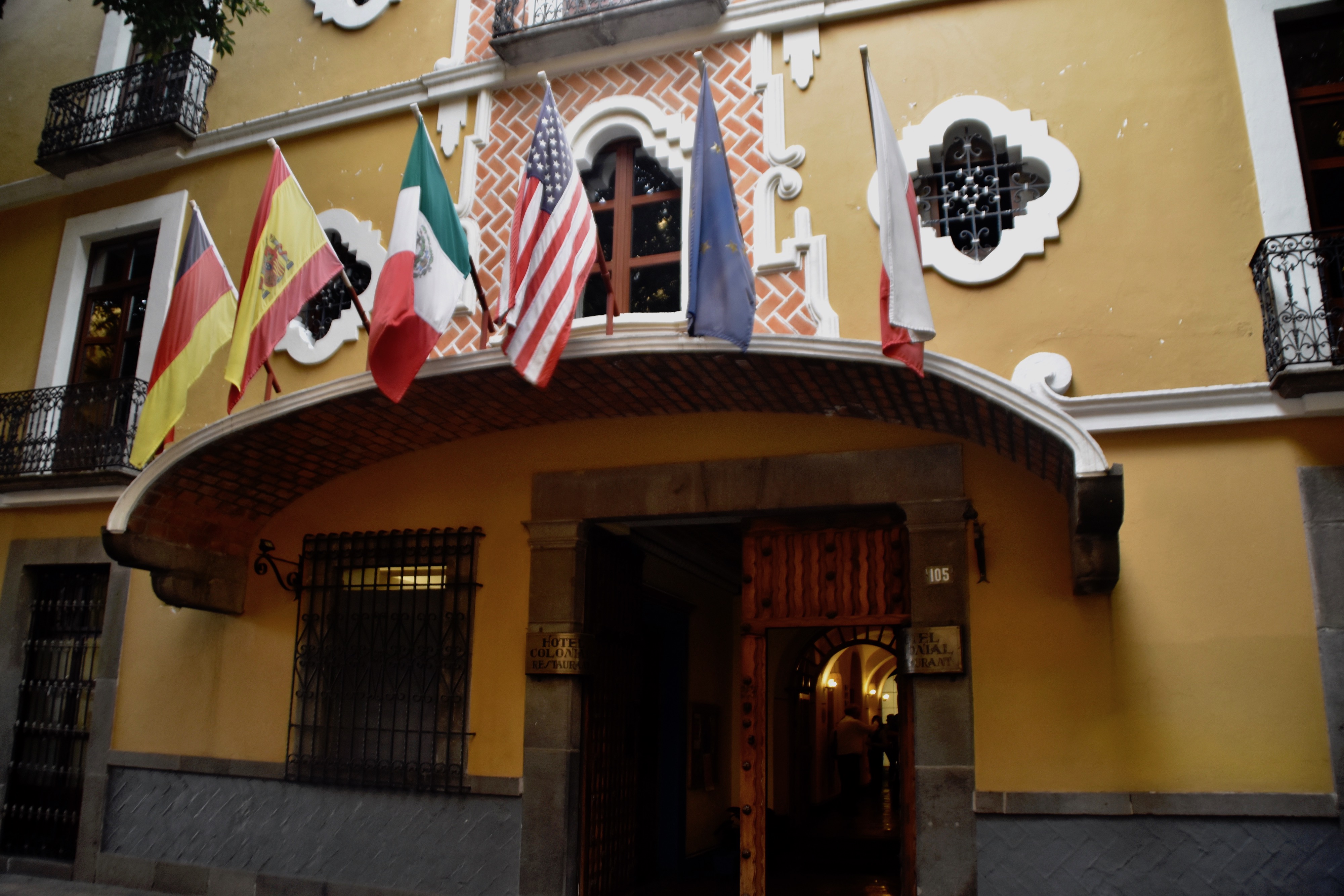
Our lodgings in Puebla are at the Hotel Colonial which dates all the way back to 1698 when it was built by the Jesuits. It has been a hotel for over 150 years and is absolutely right in the heart of the old city, only a block from the Zócalo and the cathedral. It is not a luxury hotel, but more than suitable for our needs. Alison and I are given a corner room on the third floor from where we have a great view of the pedestrian street below.
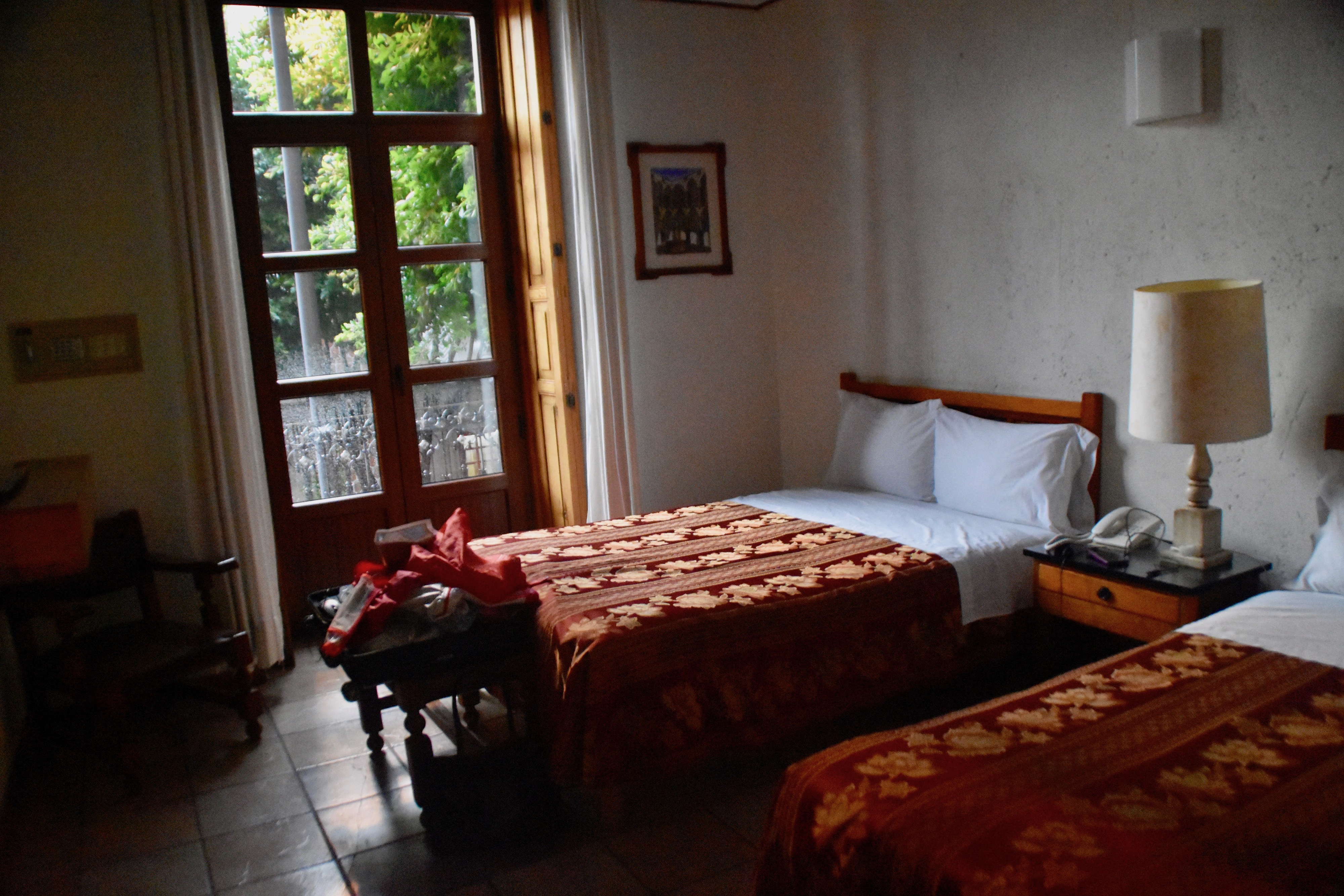
Even though it’s room 208, in Mexico, like Europe the ground floor is not counted, so it is the third floor.
During our two days here there was a constant bustle of activity on the street below that was entertaining and at no times overly noisy or disruptive. We watched this busker from our balcony as he kept adding layer after layer to his balancing act without ever falling.
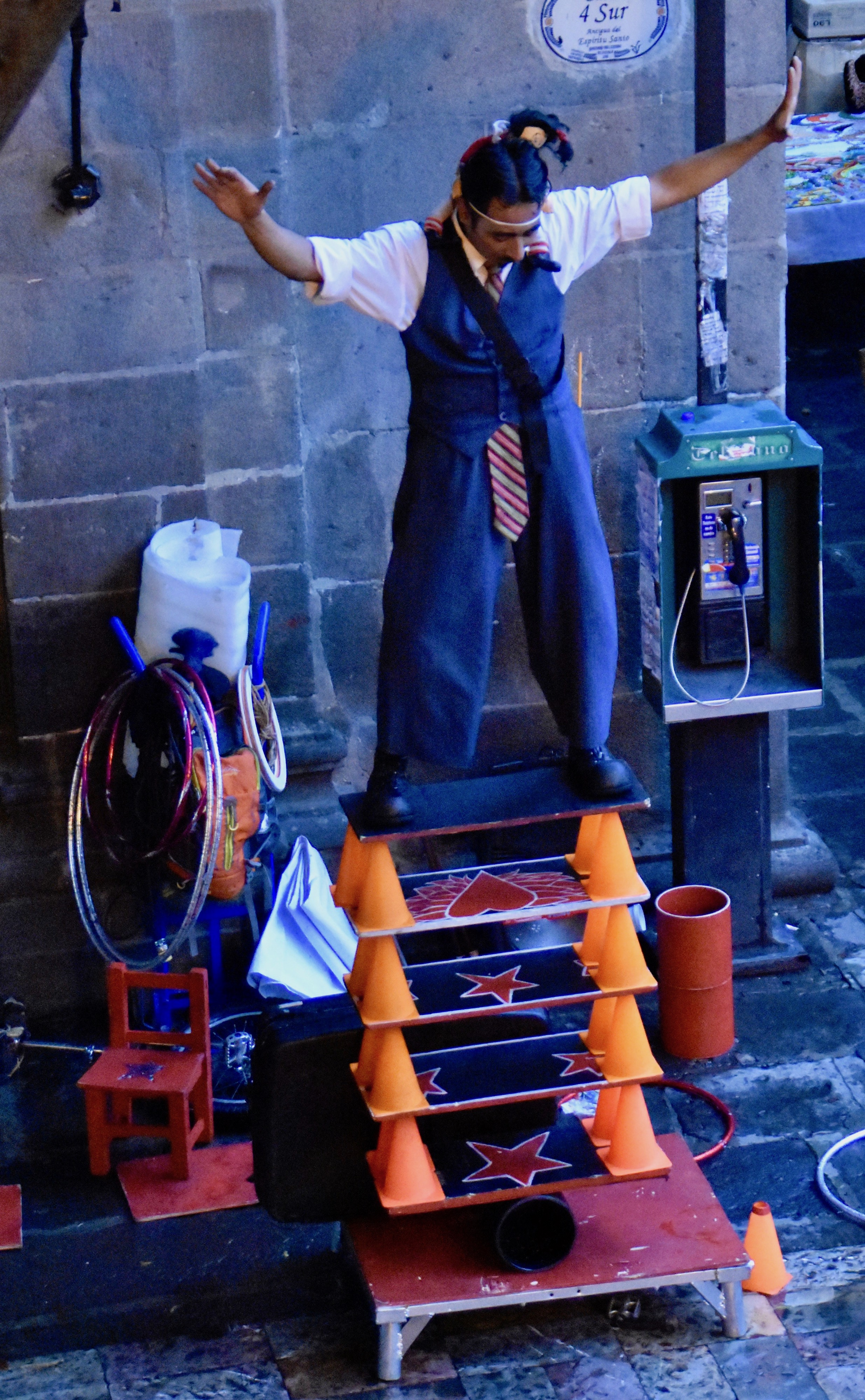
On another occasion there seemed to be some type of ceremonial wedding taking place with this wraithlike figure passing below.
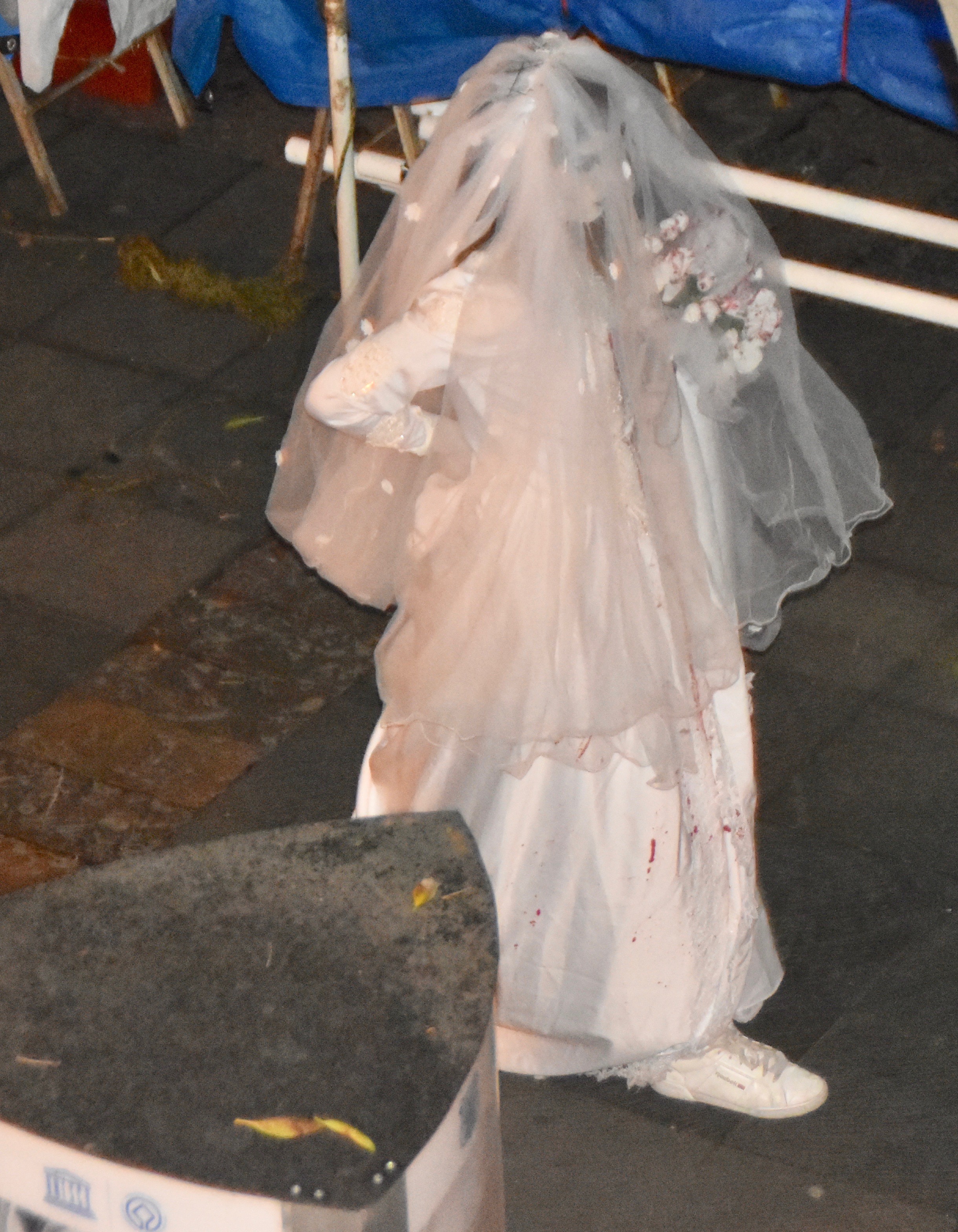
All in all we were more than satisfied with the Hotel Colonial. It certainly was not as luxurious as the Quinta Real where we had spent the previous four nights in Oaxaca, but it was clean, had a great location and had plenty of character and maybe even a few Jesuit ghosts.
It had been a long drive from Oaxaca and after settling into our rooms Victor led us the short distance to the Zócalo around which there were a number of restaurants. Just as Oaxaca has its own cuisine, so does Puebla. The most famous specialty is mole poblano, which if you follow the link, can have up to thirty separate ingredients. However, I have a confession to make – no matter how many times or ways I try a mole recipe that contains chocolate as does mole poblano, I just don’t get it. There’s just something about the chocolate that turns me off. On the other hand another Puebla specialty chiles en nogada I would love to try. Unfortunately it’s a seasonal dish only available in the summer.
That leaves me no choice but to cry in my beer. The tears come not from grief over not getting the chiles en nogada, but the fiery chili pepper on the rim of my michelada which is a beer concoction mixed with a variety of hot sauces and other ingredients – there are lots of different varieties all over Mexico. Some might say it’s a sad way to treat a fine Victoria lager, but heck, everything is worth trying once.
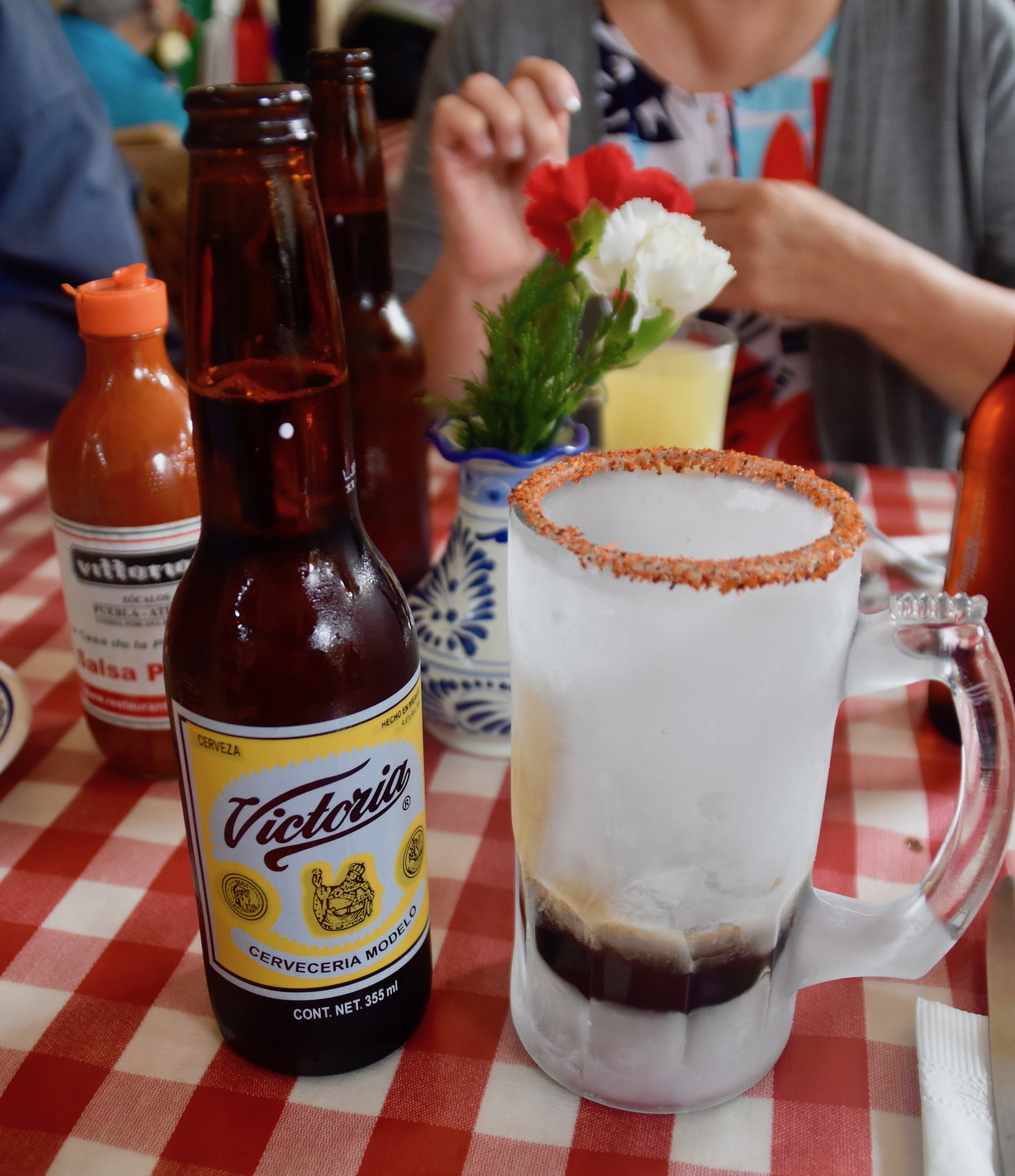
Exploring Puebla
After lunch we meet our local guide at the Zócalo for a tour of some of the most important buildings in Puebla including the cathedral, a famed Dominican church and a hidden nunnery, but first some words about the Zócalo. I says words, because unlike Mexico City’s Zócalo which is completely wide open, Puebla’s is tree lined and dotted with fountains that really make it hard to get a good picture, even with a wide-angle. I couldn’t even find a photo on the web that does it justice. Suffice it to say that it’s a wonderful public space, alive with people enjoying themselves, few of whom are foreign tourists. It’s a place to just sit on a bench by one of the fountains and watch and daydream. I especially enjoyed it early in the morning as the sun was just lighting up the tiles of the buildings that surround the Zócalo and I came here then both days we were in Puebla. This photo doesn’t quite catch the effect, but I hope it encourages you to do the same when you come to Puebla.

Back to the walking tour.
Puebla Cathedral
Unfortunately the afternoon we visited Puebla Cathedral it was overcast and I was not satisfied with my photos so I am using this one by Alfredo Reyes to illustrate the exterior.
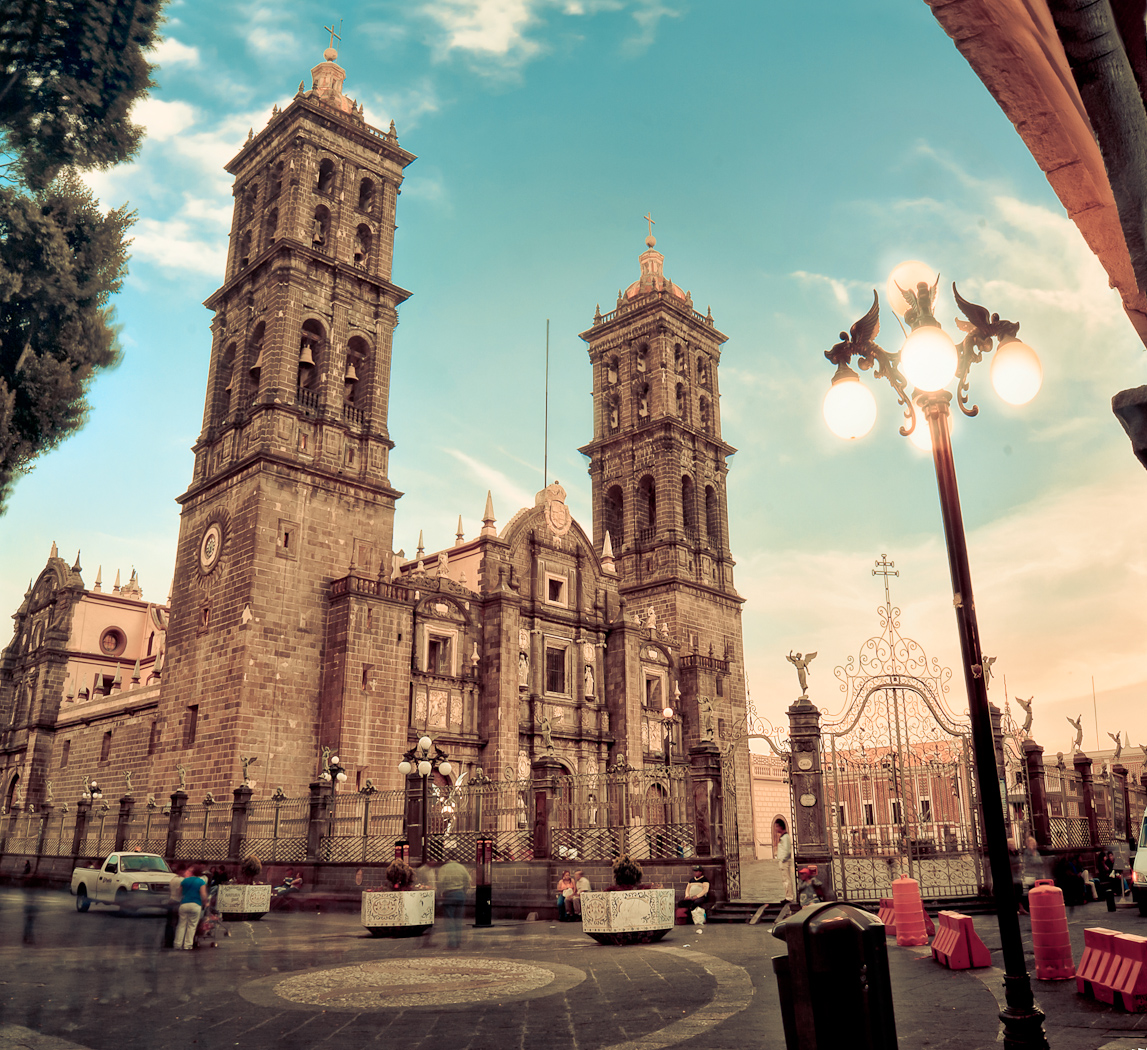
It’s an interesting, but not awe inspiring exterior by any means. What is of interest is the dome which is not visible in the above photograph. I took this photo the next morning when it was clearer. You can see the use of azulejos in creating the dome plus the use of brightly coloured paint to create the ‘Puebla’ effect.

The cathedral was begun in 1575 and wasn’t finished until 1649 after a number of starts and stops. The bell towers are the tallest in Mexico and only the one on the left has a bell. Our guide related, with obvious tongue in cheek, how when the huge bell arrived nobody knew how to get it up to its position in the bell tower so it was just left on the ground and everybody went home. In the morning the bell was gone and all and sundry were really pissed that someone had stolen the damn thing. Then a cry came out from the bell tower – the bell was in its place on the tower. Obviously angels had appeared in the night and delivered the bell to its rightful position. Praise be to God for a miracle!
This is the bell tower with minor bells only in the picture. The miracle bell is out of sight.
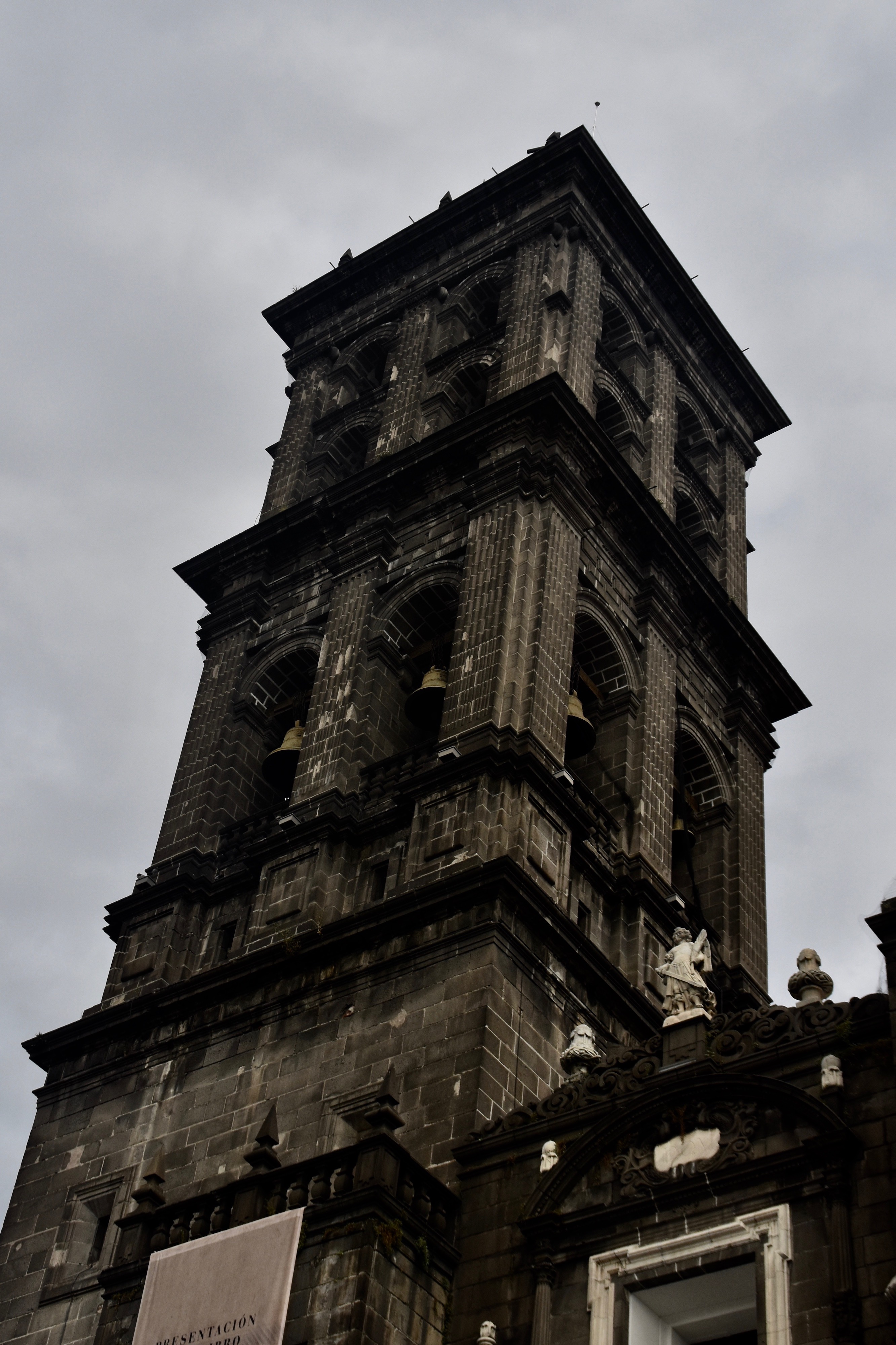
One of the exterior doors contained a very interesting sculptured panel. It depicts the Ecstasy of St. Theresa who was a Spanish nun known for her mysticism and visions that at times sent her into paroxysms of orgasmic rapture. At the time people in Avila thought she was nuts, but after her death her legend grew and she was canonized in 1622 which would have been not long before this work was done.
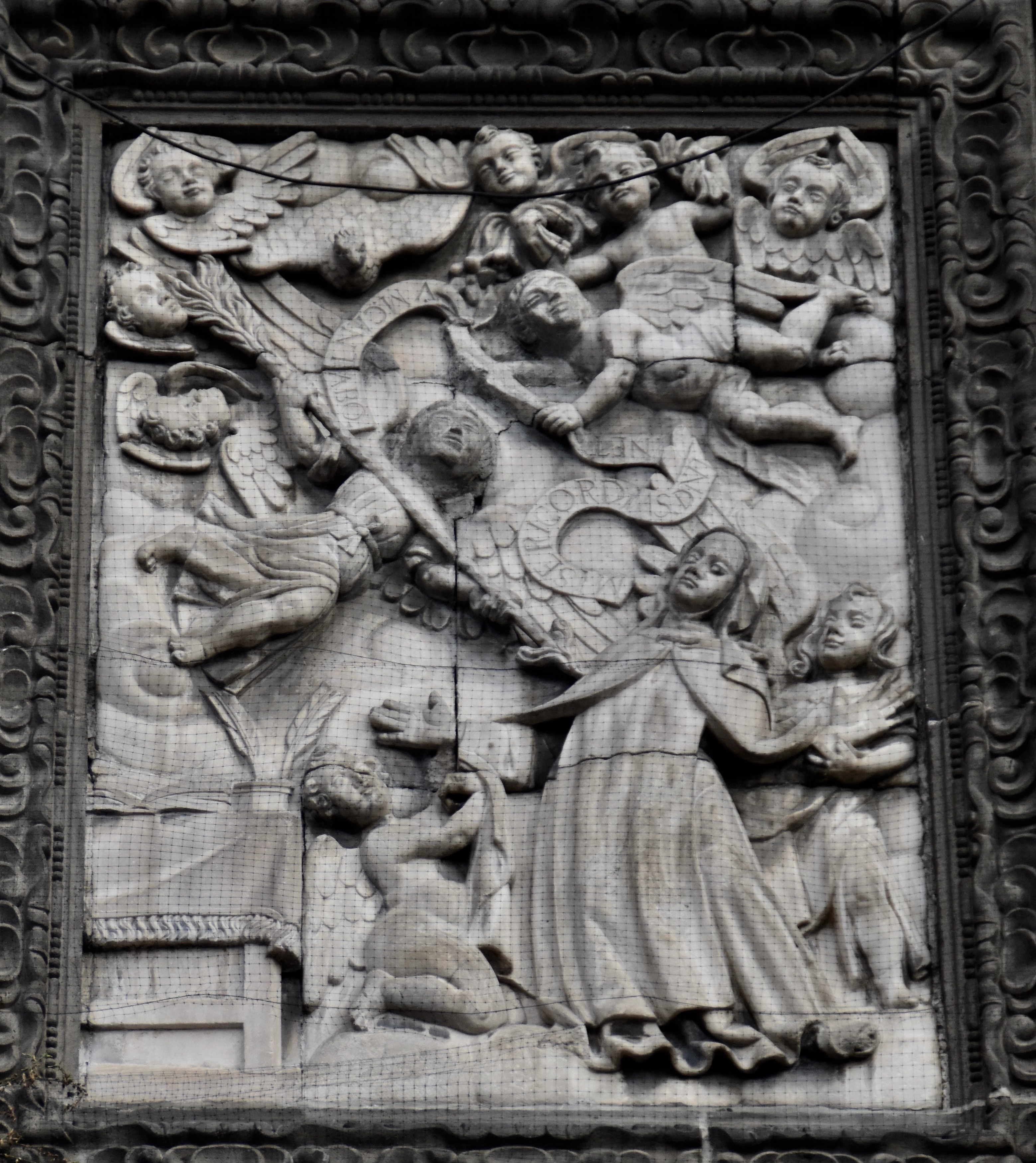
However, on looking at this, I could not get over its similarity to Bernini’s master work of the same name which can be found in Rome’s Santa Maria della Victoria church. It is considered one of the greatest sculptures ever made and I certainly concur. It has a power that can only be experienced upon seeing it in person and I never fail to drop into the church whenever I get to Rome. It was completed in 1652, just around the time Puebla Cathedral was being consecrated. Can it be a coincidence that both sculptures show an angel about to pierce the body of St. Theresa with an oversized arrow? Some suggest that in Bernini’s version the arrow is aimed elsewhere, but let’s not go there. Our guide was not able to answer my question as to whether or not the two works were connected, but I’m betting that whoever sculpted the one in Puebla had been to Rome and seen Bernini’s masterpiece.
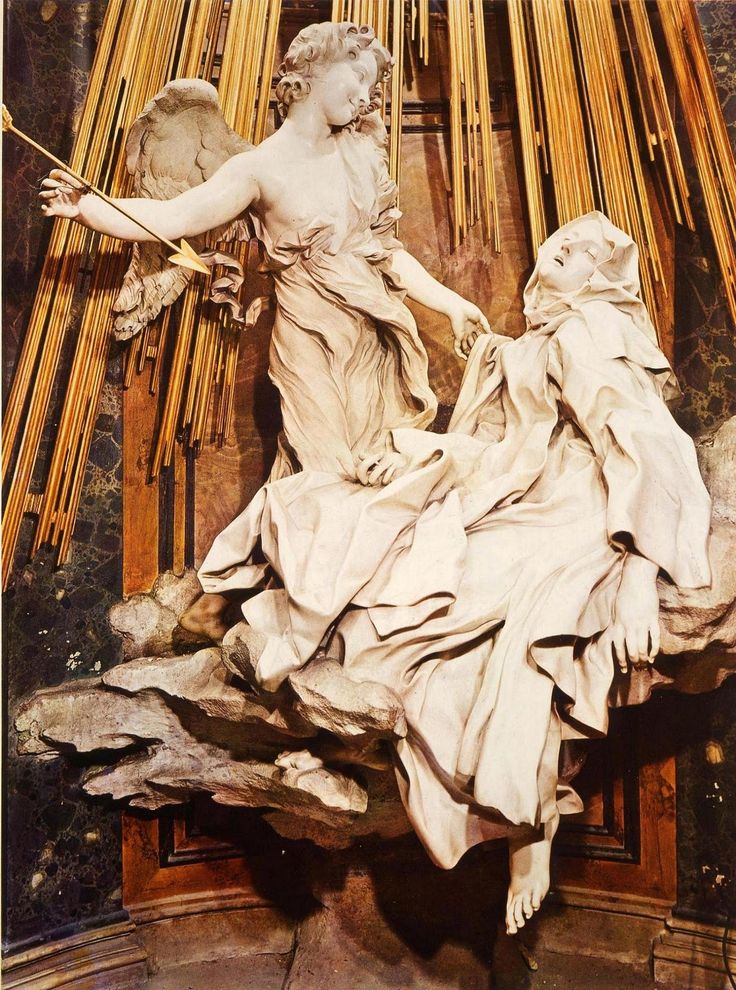
The interior of Puebla Cathedral didn’t do much for me other than the fabulous Altares de Muertos constructed for the Day of the Dead celebrations.
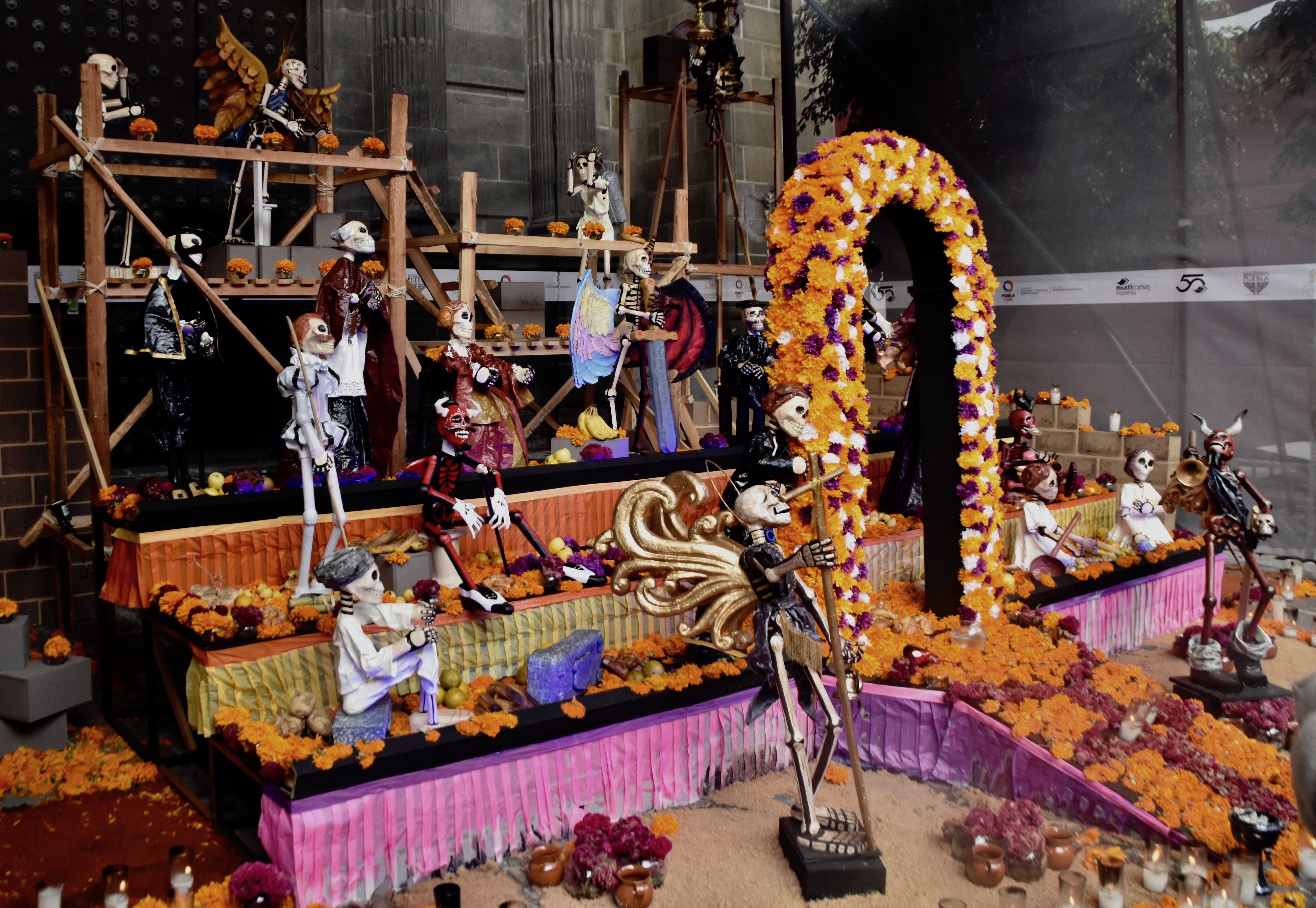
I’ve mentioned in earlier posts on this trip about the fact that every institution in Mexico including without fail, the churches, builds one of these. I’ve also mentioned the obvious syncretism that makes up so much of what is religion in Mexico today. The old traditions of the Aztecs, Mayans, Zapotecs and others have not disappeared, they have just morphed into a unique form of Catholicism that I find fascinating. Just look at these images and tell me that the ancient fascination with death and blood has been washed away.

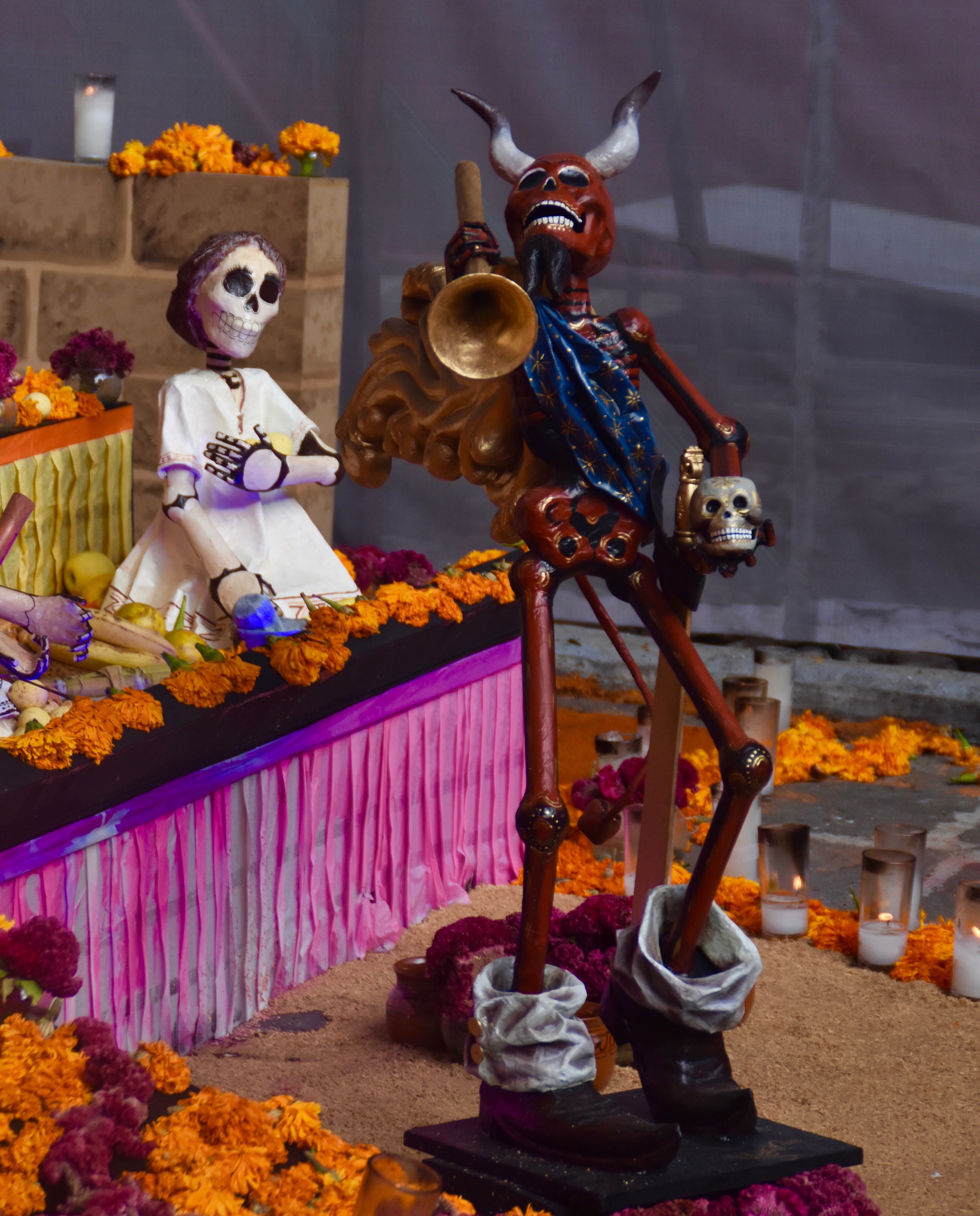
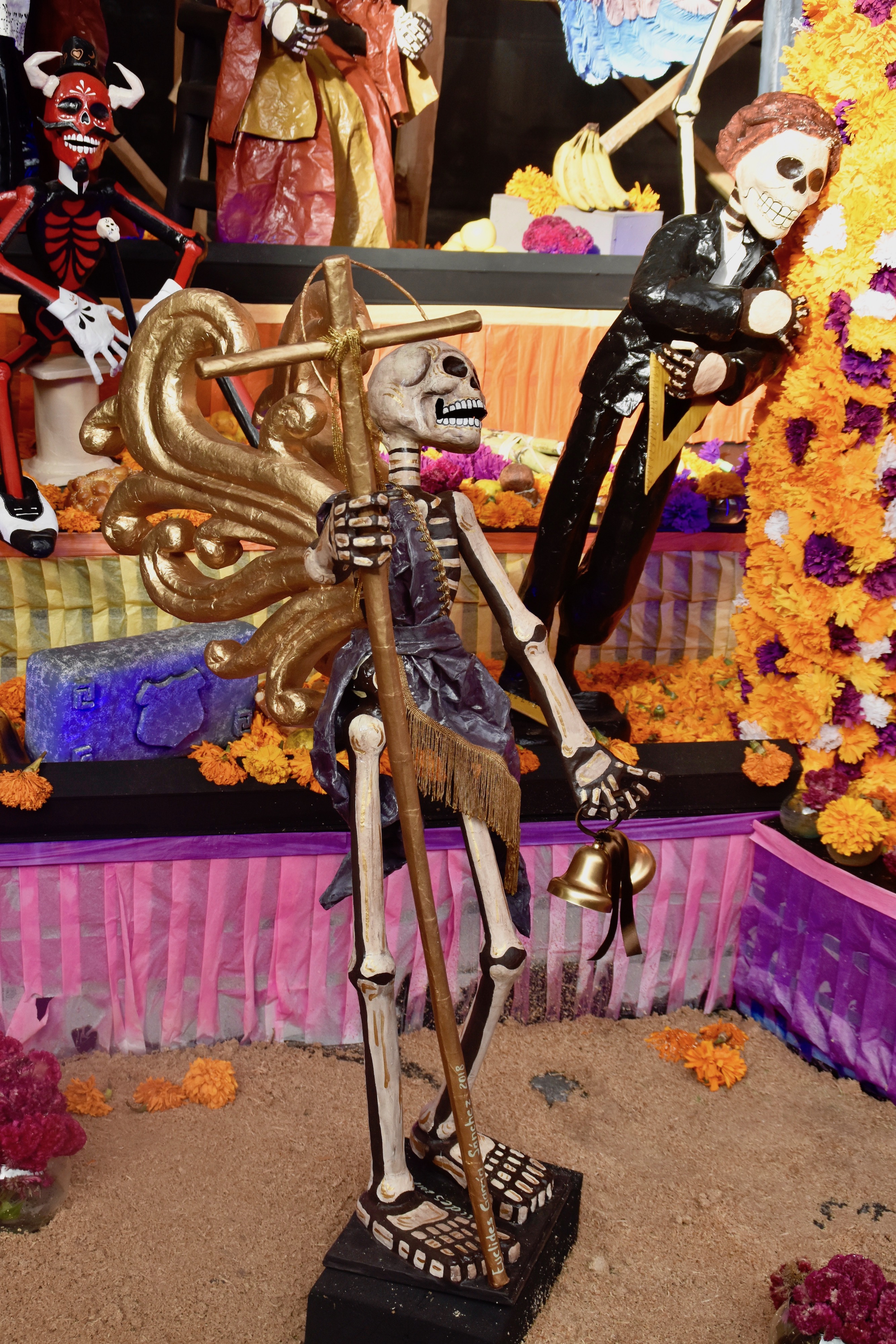
Templo de Santo Domingo
This is the somewhat bland exterior of the Templo de Santo Domingo which was built by the Dominicans in the early 17th century. Inside is said to be the “Eight Wonder of the World”. Let’s find out if that’s true.

The Capilla del Rosario (Rosary Chapel) is considered to be the finest example of what is known as New Spanish Baroque and I’m not kidding when I write that it has been referred to as the Eight Wonder of the World. In fact it’s still referred to as that in the official tourist literature the city produces. Strangely, in this publication, 10 Things You Need To Know About Puebla it comes in at number ten. You would think if it was the eight best in the world it would at least rate number one in Puebla. Anyway, here it is in all its golden glory and yes, all that glitters in Capilla del Rosario is gold.
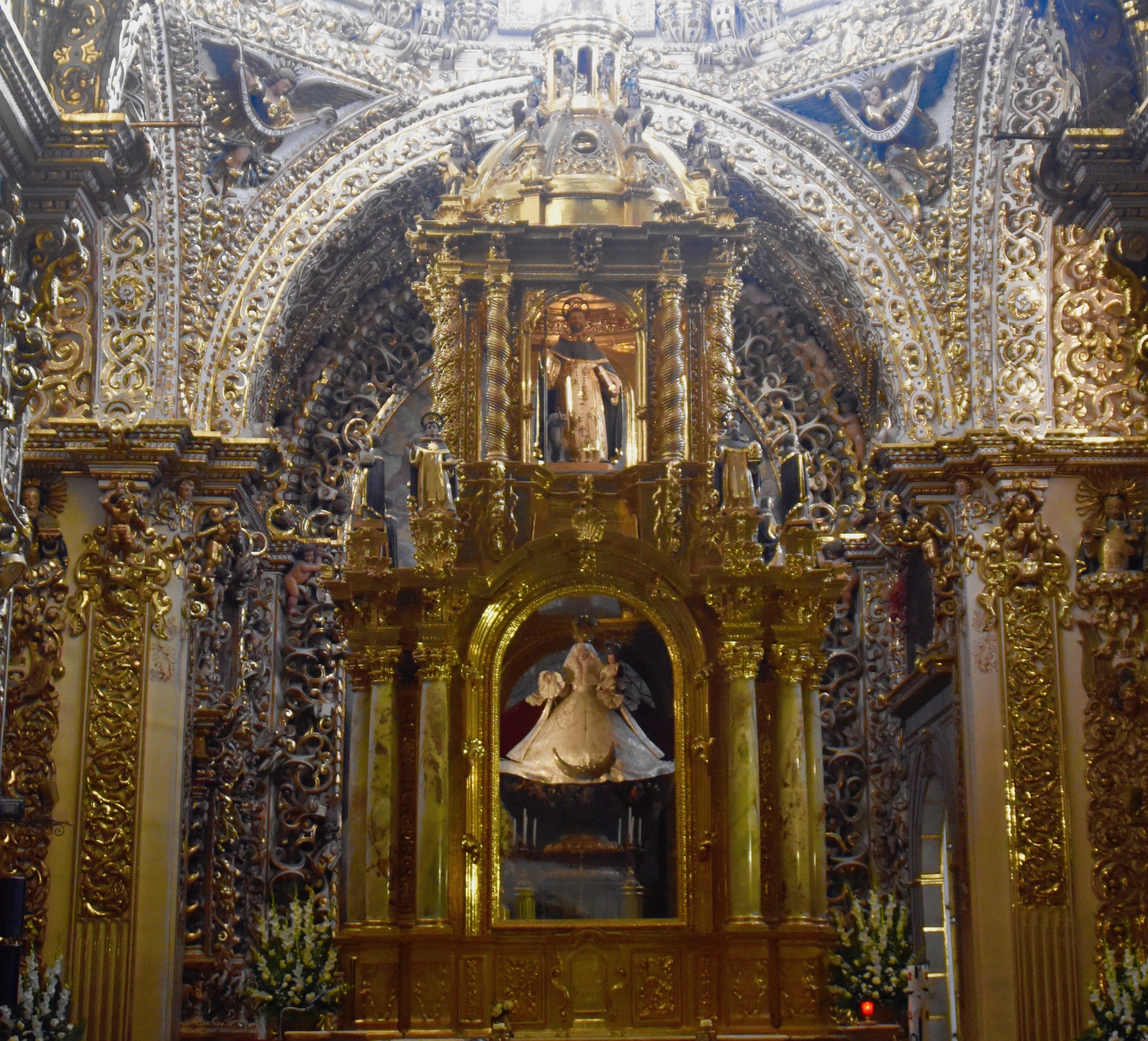
This is the ceiling.
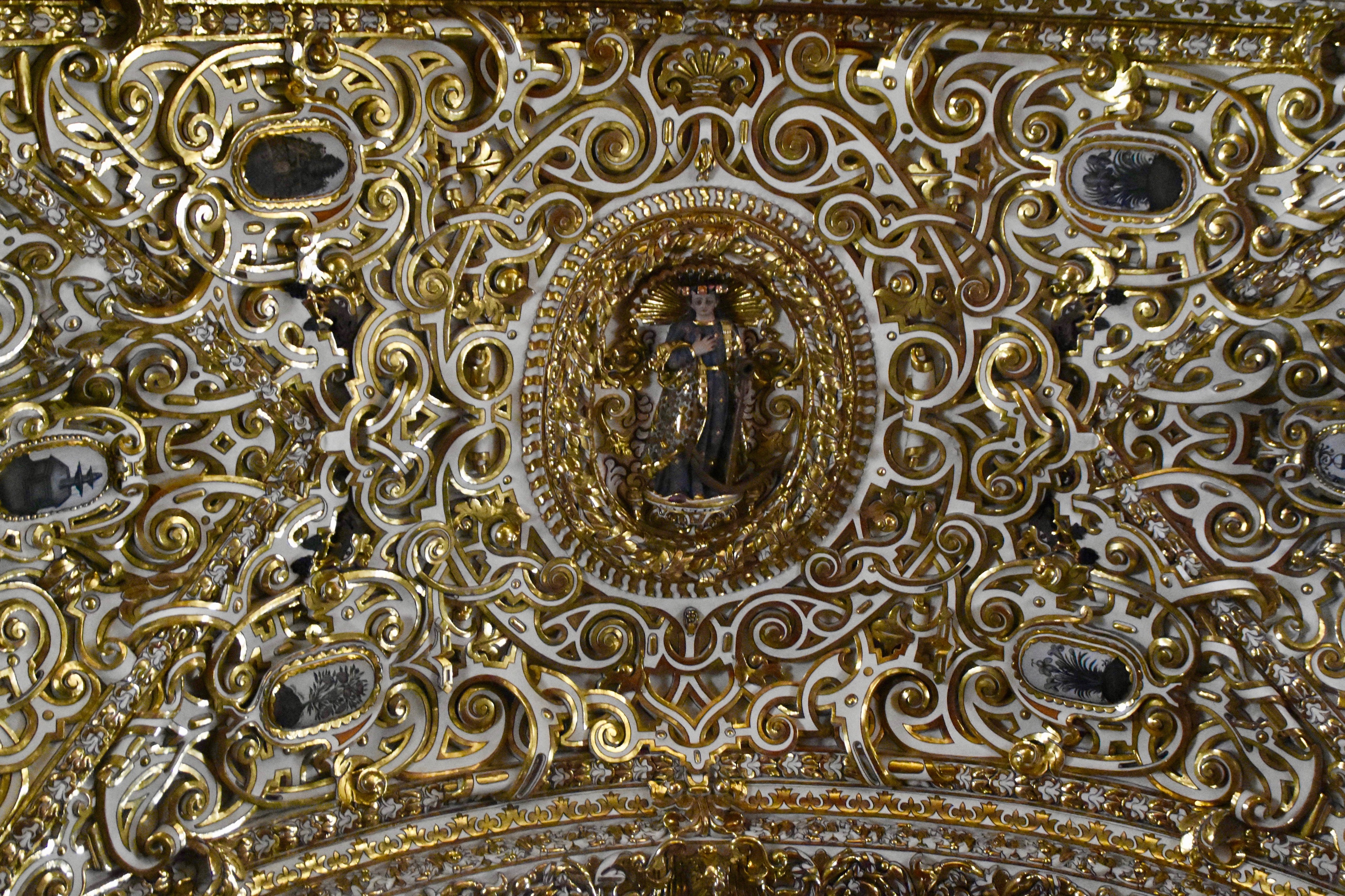
I really don’t know what to write about this. It’s definitely not the eight wonder of the world, probably not even the 800th, but there is so much gold that it does literally gleam. Is it awe inspiring? Lots of people think so, but to me it’s more like, “Aw, why did they need to steal that much gold and who did they steal it from?” Last time I checked the Dominicans weren’t known for their mining prowess.
I’m glad I saw the Capilla el Rosario, but probably not for the reasons the Puebla Tourism Authority would expect people to want to see it. It reinforces what an oppressive force the Catholic church became in Mexico with its lust for gold and riches at the expense of actually benefiting the lives of ordinary Mexicans. So much so that in the end the Mexicans turned violently against the church and ended its oppression once and for, which brings us to a natural segue into the next place we’ll visit.
Museo de Ste. Monica
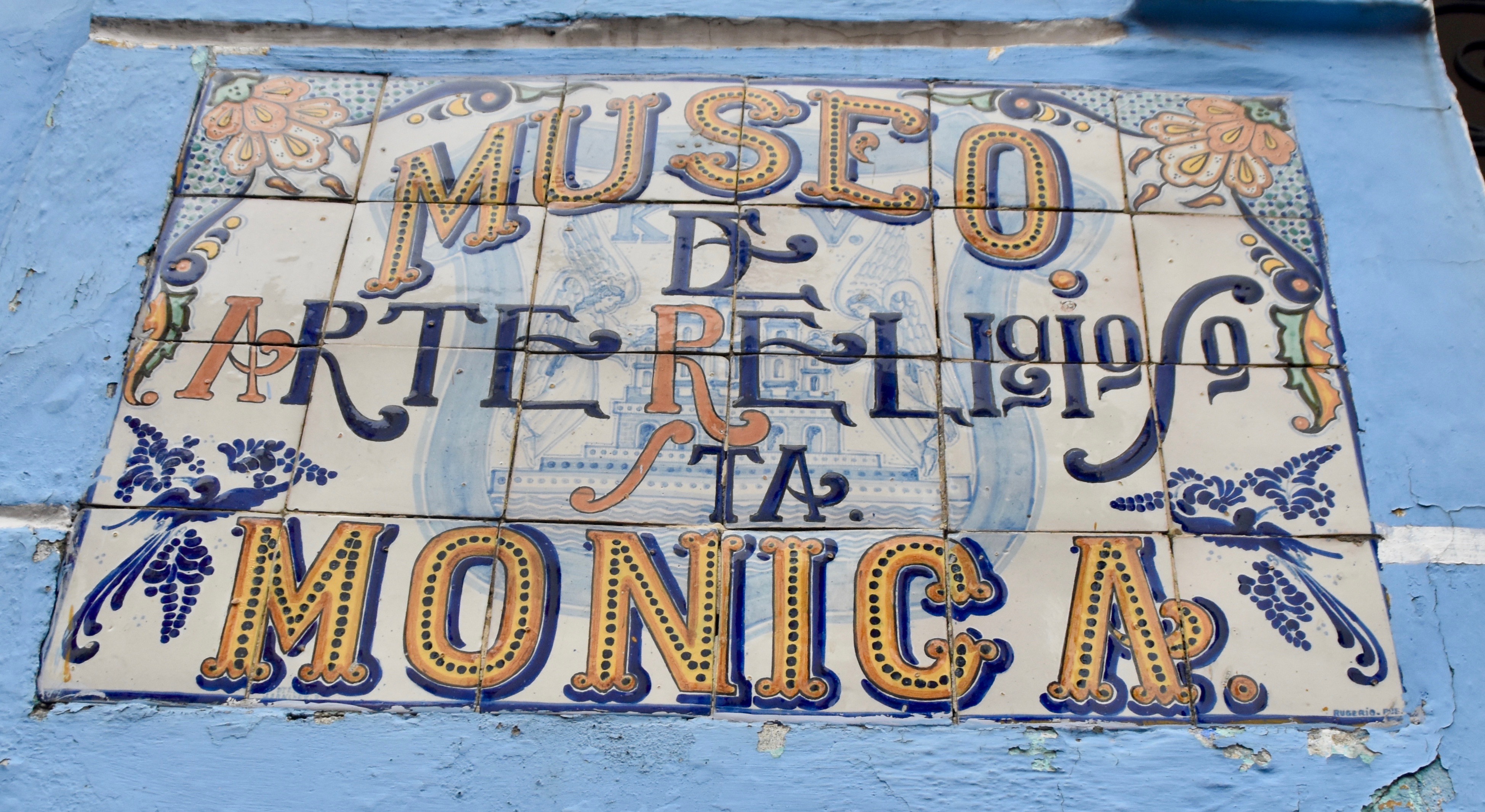
In 1857 Mexico adopted a new constitution that effectively nationalized all church property and ended its role as a political player always on the side of conservative forces in the back and forth of Mexican politics since independence in 1821. However, the church did not stop its meddling and actively supported the two French attempts to take over Mexico. Eventually most Mexicans were fed up and they turned on the church and treated priests and nuns as subversive enemies. The shoe was now on the other foot and the clergy were forced to go into hiding. Graham Greene’s The Power and the Glory is based on one such priest in the province of Tabasco and is well worth reading if you want to know more about the long and shaky relationship between church and state in Mexico.
Believe it or not until 1934 the Museo de Santa Monica was a secret convent where nuns lived behind closed walls going about their business unbeknownst to outside authorities for decades. Today its the repository of a large number of religious art works as well as an example of the how nuns led their lives without anyone knowing they were there.
Some of the art work was good, but most I thought were more interesting for their historical context like this painting depicting nuns following Jesus to presumably their own crucifixions. Clearly they believed that it was their life after death that was more important than their material existence.
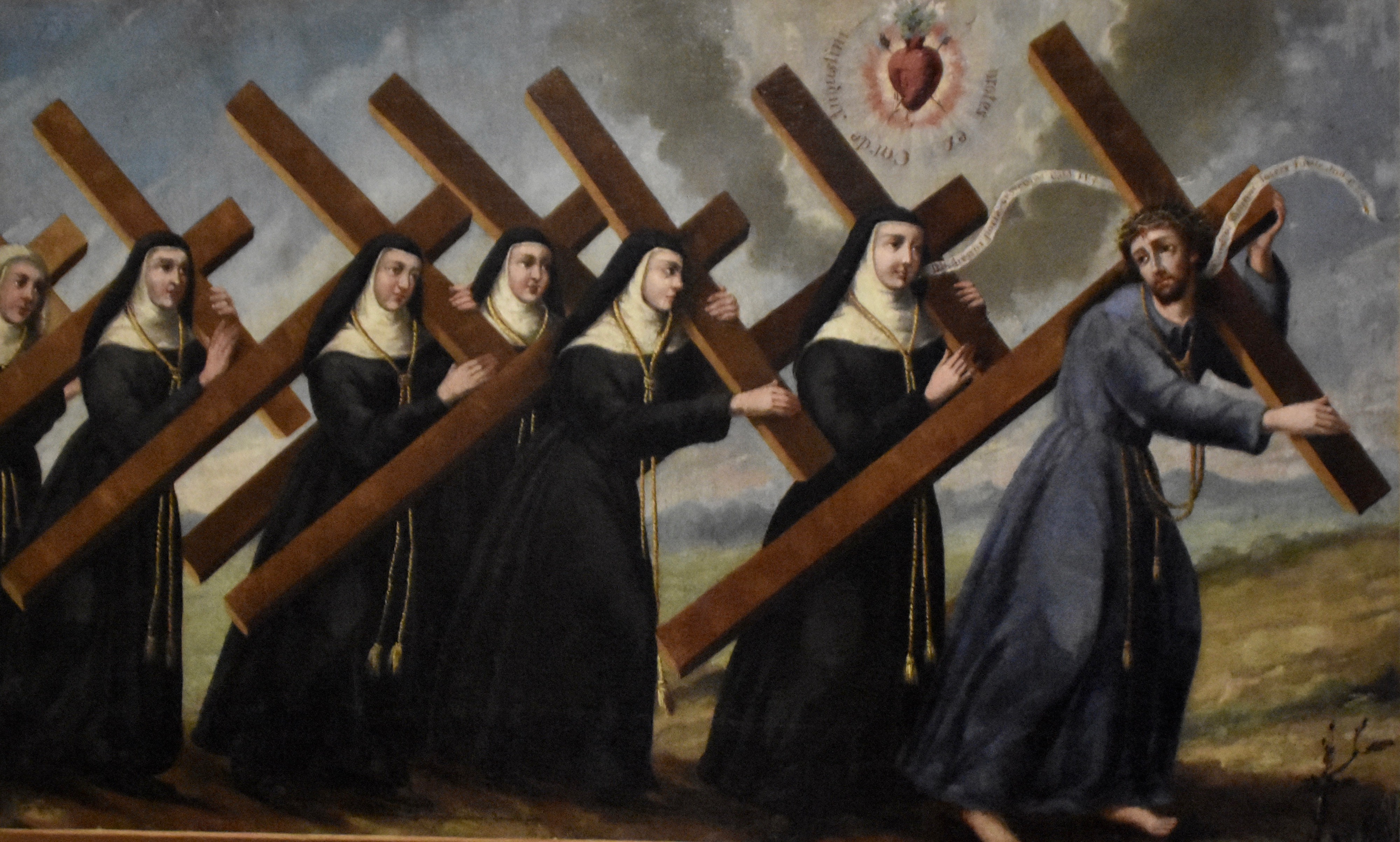
This Last Supper works very well as a piece of folk art.
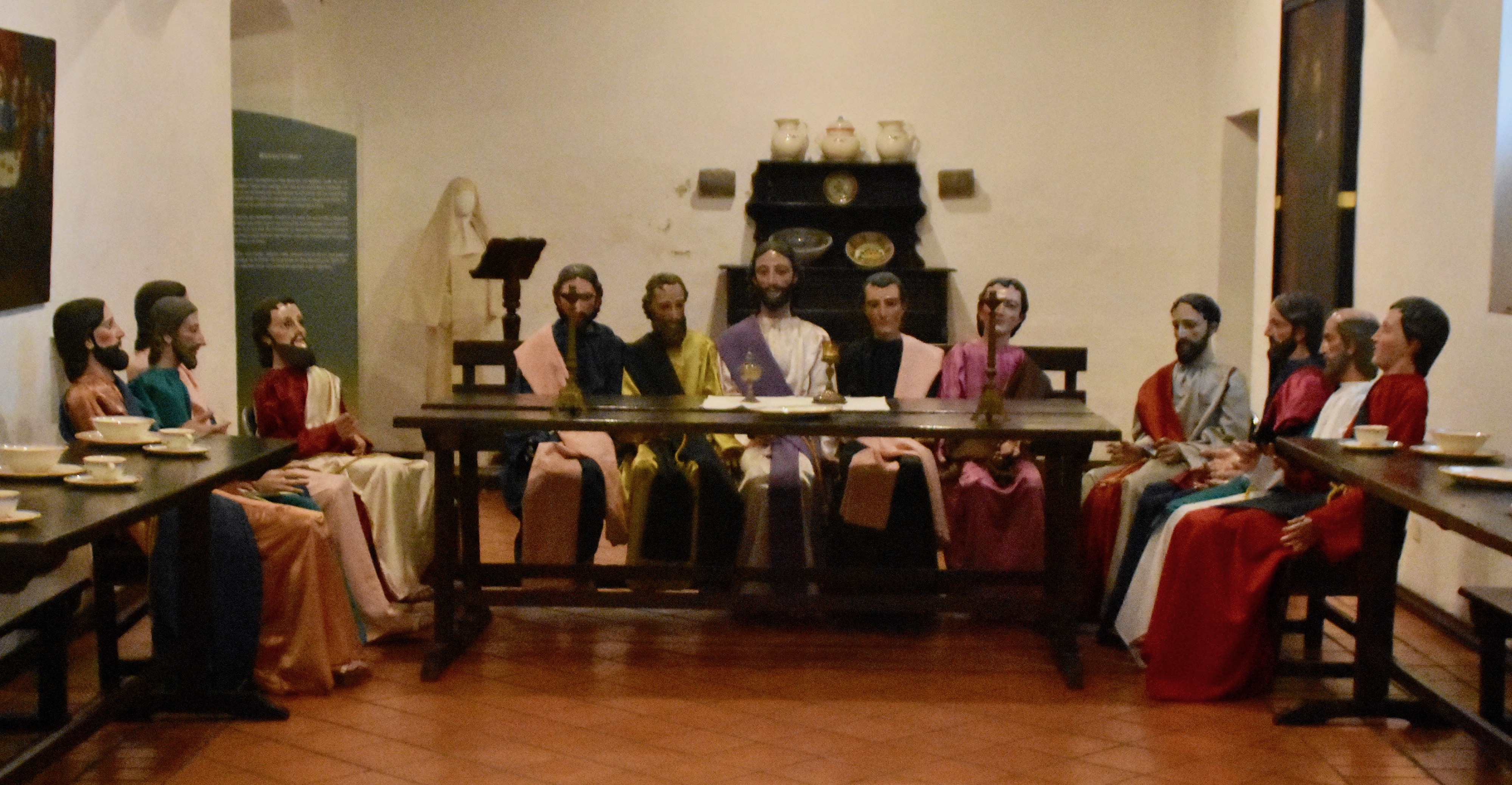
As does this tableau of nuns.
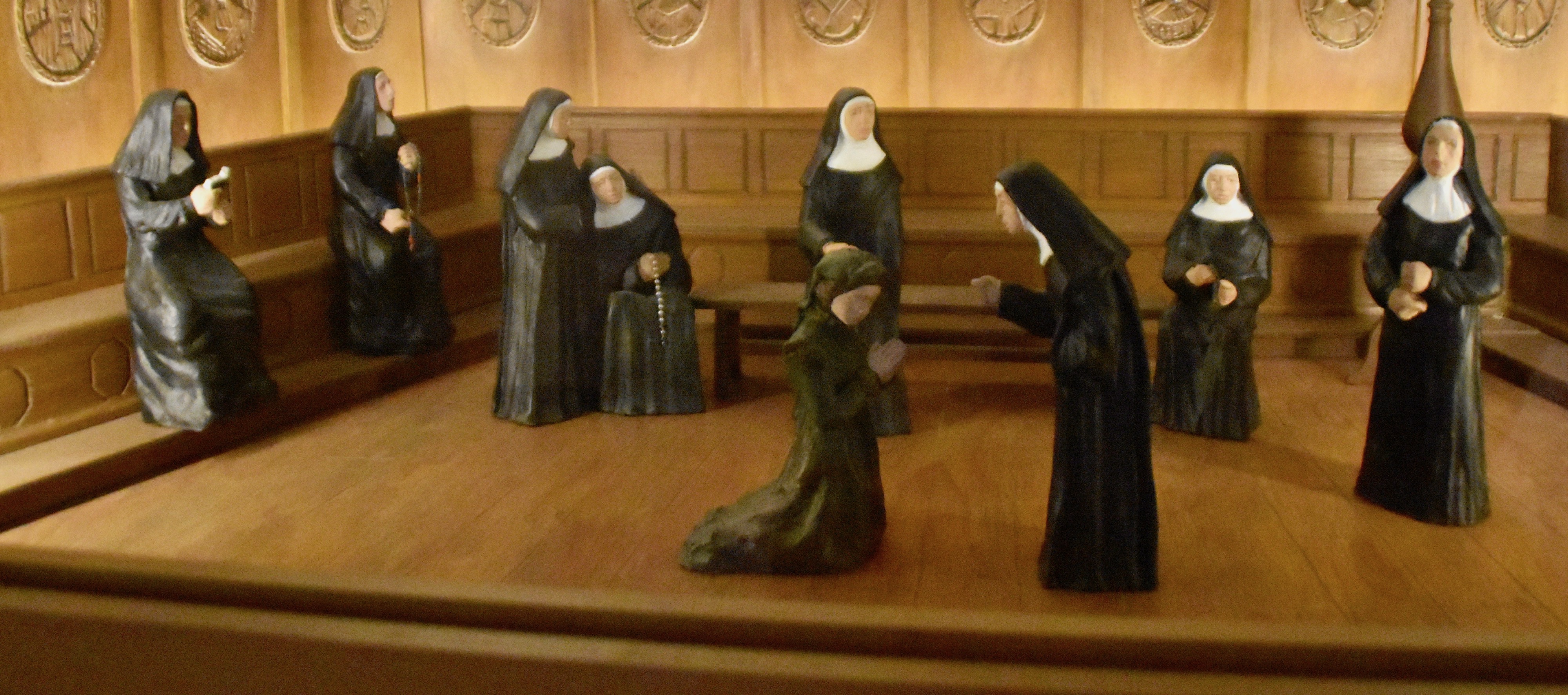
The visit to the Santa Monica Convent was the end of our Puebla walking tour. I realize that much of this post has been anti-clerical, but I am glad we visited these places. It was Saint Augustine who said “The world is a book and those who do not travel read only one page” and this was a page I needed to read.
For me the best part about Puebla was just wandering through as many of the historic streets as I could, taking in the atmosphere of the place. Or ducking into one of the many ceramic shops selling the Talavera pottery that is unique to Puebla.
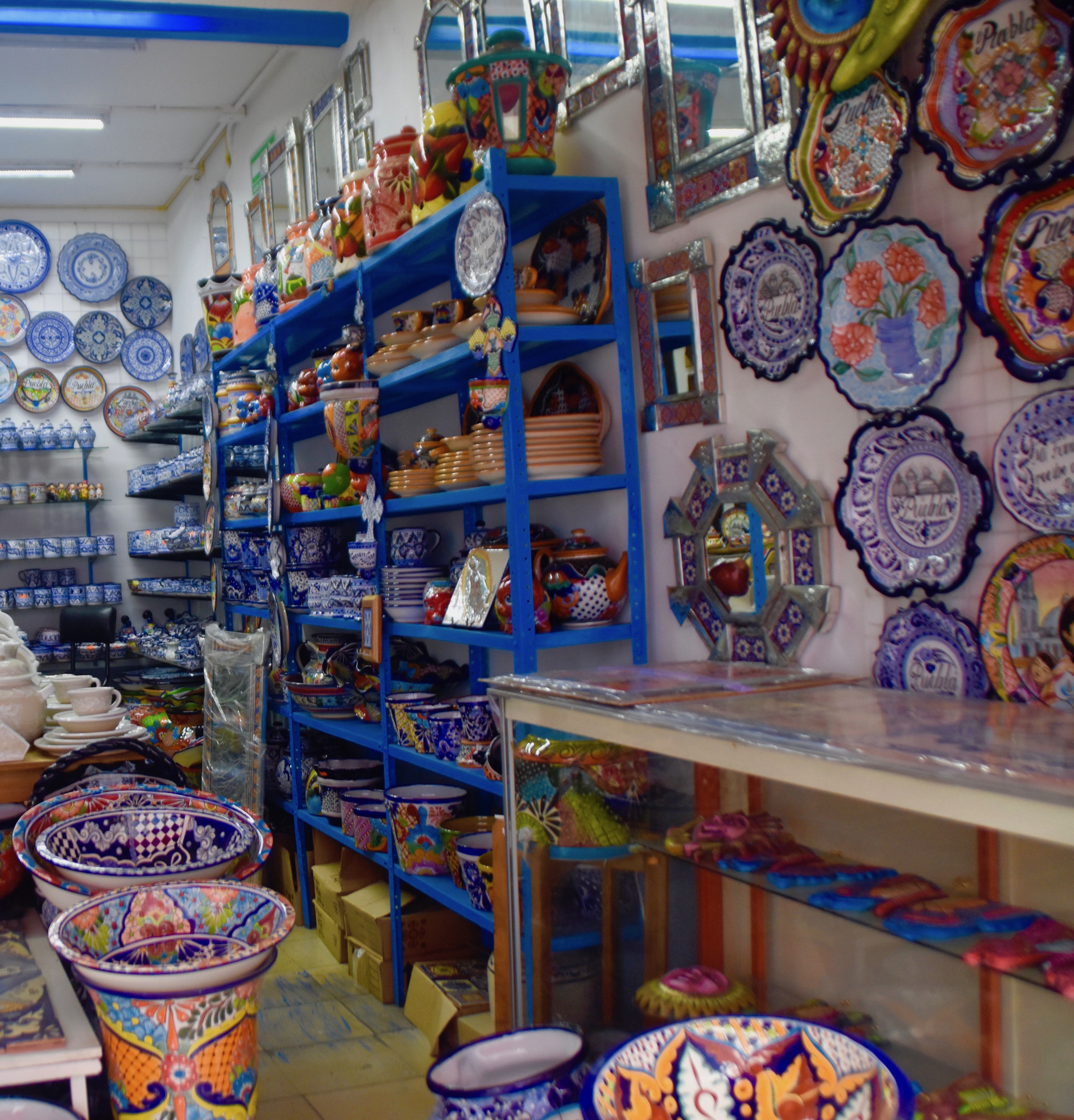
Or sitting in an outdoor cafe enjoying a cerveza, this time sans the chili powder, and watching the world go by. Life could be a lot worse – I could be hiding out in a nunnery.
In the next posts we’ll use Puebla as a base from which to explore the important archaeological sites of Cacaxtla and Cholula. I hope you’ll join us.

